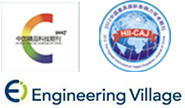Abstract:
The aim of this study was to investigate the effect of poplar wood fiber as a bio-nucleating agent on the mechanical properties and crystallization behaviors of poly(lactic acid) (PLA), and compare with common nucleating agents talc powder and hydrazide compounds. Poplar wood fiber (WF) (0.5wt%, 1wt%, 2wt%, 4wt%), talc powder (Talc) (1wt%, 2wt%, 4wt%, 8wt%) and hydrazide compounds (TMC-300) (0.3wt%, 0.5wt%, 1wt%, 2wt%) were blended with PLA to prepare composite at various contents by extrusion and molding process, respectively. The optimal content of each nucleating agent was determined based on mechanical properties of composites. The effect of WF, Talc and TMC-300 under optimal content on the crystallization properties including crystallization behaviors, crystal morphology and structure of PLA-based composites was compared. All the three types of nucleating agents can improve the notched impact strength of PLA. Compared with Talc and TMC-300, the addition of WF results in more significant improvement in tensile and flexural properties of PLA-based composite. Under the optimal addition content (1wt%) of WF, the elongation at break, tensile and flexural strength increase by 27%, 17% and 18% in comparison with neat PLA, respectively. The effect of WF, Talc and TMC-300 on the crystallization behaviors of PLA was studied through differential scanning calorimetry. Results show that adding 1wt% WF can improve the crystallinity of PLA in the non-isothermal crystallization, but it is much lower than that of composite with 1wt% Talc and 0.5wt% TMC-300. According to the isothermal crystallization kinetic analysis, WF can also reduce the half-crystallization time of PLA matrix, and improve the crystallization rate. The half-crystallization time under isothermal crystallization at 110℃ is reduced from 23.6 min (neat PLA) to 7.2, 2.7 and 1.4 min when adding 1wt% WF, 1wt% Talc and 0.5wt% TMC-300, respectively. Hot-stage polarized light microscope observation shows that the crystal morphology of PLA induced by various nucleating agents is different during 110℃ isothermal crystallization. WF and Talc provide a large number of nucleation sites for PLA crystallization, which promotes the grain refinement of PLA. TMC-300 induces PLA to form fibrous bundle-like crystals accompanied with higher crystallization rate, which is consistent with isothermal crystallization kinetic analysis results. The SEM observation of impact facture morphology after etching treatment indicates that the accumulation of crystals with different morphologies is one reason for the difference of mechanical properties. Wide angle X-diffraction analysis shows that all the three types of nucleating agents can promote the generation of orderly α-crystal. The diffraction peak intensity of α
(110)/(200) crystals is highest when adding WF. Besides, WF can significantly decrease the crystal size of PLA. This study demonstrates that poplar wood fiber can be used as a bio-nucleating agent for PLA, which plays dual effect of reinforcement and nucleation. This study provides a basis for optimizing the nucleation ability of WF for PLA, and also provides references for further promoting the green development of wood-plastic composite.


 下载:
下载: